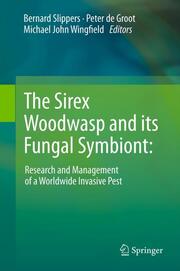Detailansicht
The Sirex Woodwasp and its Fungal Symbiont:
Research and Management of a Worldwide Invasive Pest
ISBN/EAN: 9789400719590
Umbreit-Nr.: 1182466
Sprache:
Englisch
Umfang: xii, 301 S.
Format in cm:
Einband:
gebundenes Buch
Erschienen am 20.10.2011
Auflage: 1/2011
- Zusatztext
- The Sirex woodwasp, Sirex noctilio, is the most important invasive alien insect pest of Pinus plantations in the Southern Hemisphere. It now also threatens pines in North America. This book brings together the worldwide knowledge of researchers from Universities and Government institutions, as well as forest industry practitioners that have worked on the pest. Importantly, it is the first comprehensive treatment of the subject since S. noctilio was discovered outside its native range around 1900. The book covers all aspects of the biology and management of S. noctilio, including aspects of the insects taxonomy, general life history, host-plant relationships, population dynamics, chemical ecology and symbiosis with the fungus Amylostereum areolatum. The book also contains a comprehensive synthesis of the history and current status of the pest and worldwide efforts to control it, including biological control, silviculture and quarantine.
- Kurztext
- 100 Years of experience of management and research on the most serious invasive insect pest of Pinus plantations across diverse environmentsRichly illustrated, with a broad coverage and in depth analysis of all aspects from biological research to practical field managementInsight into complex insect-fungus-tree-parasitoid-environment interactions, as well as academia-industry-government management and research interactions
- Autorenportrait
- InhaltsangabePrefaceDedication 1.0 Sirex systematics; problems and solutionsHenri Goulet1.1 Introduction1.2 Important issues for solving identification problems1.2.1 Ovipositor morphology1.2.2 Mitochondrial DNA1.2.3 Collections1.3 Diversity and biogeographic coverage1.4 Morphological characters used to recognize species1.4.1 Ovipositor characters1.4.2 Other characters2.0 Life history and biology of Sirex noctilioKathleen Ryan and Brett P Hurley2.1 Introduction2.2 Insect-fungus complex2.3 The life history of Sirex noctilio2.4 Host selection and susceptibility2.5 Host Records2.6 Factors influencing population dynamics2.6.1 Potential fecundity2.6.2 Reproductive potential2.6.3 Adult size2.6.4 Sex-ratio2.6.5 Natural enemies2.7 Conclusions3.0 Susceptibility and response of pines to Sirex noctilioJohn M Bordeaux and Jeffrey FD Dean3.1 Introduction3.2 Factors contributing to tree susceptibility3.3 Tree responses to Sirex noctilio mucus3.4 Tree responses to Amylostereum areolatum3.5 General responses to Sirex attack3.6 Reducing tree susceptibility4.0 The population dynamics of Sirex noctilio F.: the influence of diapause, spatial aggregation and flight potential on woodwasp outbreaks and spreadJuan C Corley and José M Villacide4.1 Introduction4.2 Pine plantations and Sirex noctilio in Patagonia4.3 Life cycle and adult emergence patterns4.4 Spatial dynamics of woodwasp populations at a stand scale4.5 Flight potential of Sirex noctilio males and females4.6 Conclusions5.0 The woodwasp Sirex noctilio and its associated fungus Amylostereum areolatum in EuropeBeat Wermelinger and Iben M Thomsen5.1 Introduction5.2 Biology of Sirex noctilio5.3 Natural enemies5.4 Ecology of the Amylostereum fungal symbionts 5.5 Relationships between S. noctilio attack and host quality5.6 Economic significance of S. noctilio in Europe6.0 The genetics of Amylostereum species associated with Siricids Magriet van der Nest, Rimvys Vasaitis, Jan Stenlid, Brenda D Wingfield, Michael J Wingfield and Bernard Slippers6.1 Introduction6.2 Systematics and identification6.3 Symbiotic specificity6.4 Mode of reproduction6.5 Vegetative incompatibility and population diversity studies6.6 Conclusions and future prospects7.0 Siricid woodwasps and their fungal symbionts in Asia, specifically those occurring in JapanMasanobu Tabata, Hiroaki Miyata and Kaoru Maeto7.1 Introduction7.2 Symbiosis between woodwasps and fungi7.3 Molecular phylogeny of fungal symbionts7.4 Life-cycle and host interaction of woodwasps8.0 Parasitoids in the management of Sirex: Looking back and looking ahead8.1 Introduction8.2 Use of parasitoids as biological control agents8.2.1 New Zealand and Australia8.2.2 South America8.2.3 South Africa8.3 Conclusions9.0 Factors affecting the efficacy of Deladenus siricidicola in biological control systemsBernard Slippers, Brett P Hurley, X Osmond Mlonyeni, Peter de Groot and Michael J Wingfield9.1 Introduction9.2 Rearing, handling and storage 9.3 Evolution of nematode virulence and wasp resistance 9.4 Introduction history and genetic diversity9.5 Interaction specificity - Amylostereum and Sirex9.6 Variable environmental factors9.7 Conclusions10.0 Ecological considerations in using Deladenus siricidicola for the biological control of Sirex noctilio in North Ame
